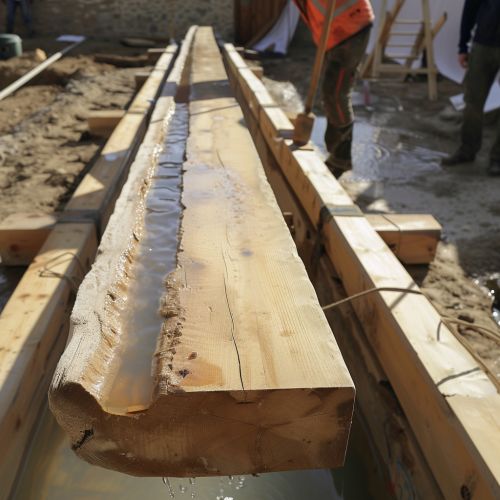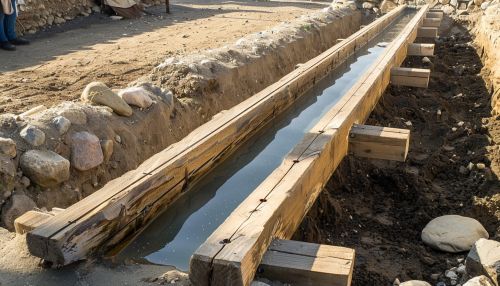Chorobates: Difference between revisions
No edit summary |
No edit summary |
||
| Line 7: | Line 7: | ||
The chorobates typically consisted of a long, straight wooden beam, approximately 6 meters in length, supported by legs or tripods at each end. The top of the beam featured a groove filled with water, serving as a primitive level. The water level in the groove indicated whether the beam was perfectly horizontal. Additionally, plumb lines were often attached to the beam to provide further accuracy. | The chorobates typically consisted of a long, straight wooden beam, approximately 6 meters in length, supported by legs or tripods at each end. The top of the beam featured a groove filled with water, serving as a primitive level. The water level in the groove indicated whether the beam was perfectly horizontal. Additionally, plumb lines were often attached to the beam to provide further accuracy. | ||
[[Image:Detail-79405.jpg|thumb|center|Reconstruction of a chorobates, showing a long wooden beam with a water-filled groove and plumb lines.]] | [[Image:Detail-79405.jpg|thumb|center|Reconstruction of a chorobates, showing a long wooden beam with a water-filled groove and plumb lines.|class=only_on_mobile]] | ||
[[Image:Detail-79406.jpg|thumb|center|Reconstruction of a chorobates, showing a long wooden beam with a water-filled groove and plumb lines.|class=only_on_desktop]] | |||
The beam was often marked with graduated scales to measure deviations from the horizontal plane. These scales allowed surveyors to make precise adjustments and ensure the accuracy of their measurements. The legs or tripods supporting the beam were adjustable, enabling the device to be used on uneven terrain. | The beam was often marked with graduated scales to measure deviations from the horizontal plane. These scales allowed surveyors to make precise adjustments and ensure the accuracy of their measurements. The legs or tripods supporting the beam were adjustable, enabling the device to be used on uneven terrain. | ||
Latest revision as of 08:49, 18 May 2024
Introduction
The chorobates is an ancient Roman surveying instrument used primarily for measuring horizontal planes. It is considered a precursor to the modern spirit level, and its design reflects the ingenuity of Roman engineering. The device was essential for constructing aqueducts, roads, and other infrastructure projects that required precise leveling over long distances.
Design and Construction
The chorobates typically consisted of a long, straight wooden beam, approximately 6 meters in length, supported by legs or tripods at each end. The top of the beam featured a groove filled with water, serving as a primitive level. The water level in the groove indicated whether the beam was perfectly horizontal. Additionally, plumb lines were often attached to the beam to provide further accuracy.


The beam was often marked with graduated scales to measure deviations from the horizontal plane. These scales allowed surveyors to make precise adjustments and ensure the accuracy of their measurements. The legs or tripods supporting the beam were adjustable, enabling the device to be used on uneven terrain.
Historical Context
The chorobates was an essential tool in the construction of Roman aqueducts, which required precise leveling to ensure a consistent flow of water. The Roman engineer Vitruvius described the chorobates in his treatise "De Architectura," highlighting its importance in surveying and construction. The device's accuracy and reliability made it indispensable for large-scale engineering projects.
Usage in Roman Engineering
Roman engineers used the chorobates to establish horizontal planes over long distances, a critical requirement for constructing aqueducts. The device was also employed in the construction of roads, buildings, and other infrastructure projects. By ensuring that structures were level, the chorobates contributed to the durability and stability of Roman engineering works.
Surveyors would place the chorobates at various points along the construction site, checking the water level in the groove and adjusting the supporting legs as needed. The plumb lines provided additional verification, ensuring that the beam was perfectly horizontal. This meticulous process allowed engineers to achieve the precise leveling required for their projects.
Comparison with Other Surveying Instruments
The chorobates was one of several surveying instruments used by the Romans. Other tools included the groma, used for laying out straight lines and right angles, and the dioptra, an early form of the theodolite used for measuring angles. While the groma and dioptra were essential for different aspects of surveying, the chorobates was unique in its ability to measure horizontal planes with high accuracy.
Compared to modern surveying instruments, the chorobates was relatively simple but highly effective. Its reliance on basic principles of physics, such as the behavior of water and gravity, allowed it to achieve remarkable precision. Modern spirit levels and laser levels are direct descendants of the chorobates, reflecting the enduring legacy of Roman engineering.
Preservation and Legacy
Few original chorobates have survived to the present day, but descriptions and illustrations in ancient texts provide valuable insights into their design and usage. The principles underlying the chorobates continue to influence modern surveying techniques, and its legacy is evident in the tools and methods used by contemporary engineers.
The chorobates exemplifies the ingenuity and practicality of Roman engineering. Its design reflects a deep understanding of physical principles and a commitment to precision, qualities that remain essential in modern engineering. The chorobates' contribution to the construction of Roman infrastructure underscores its historical significance and enduring impact.
